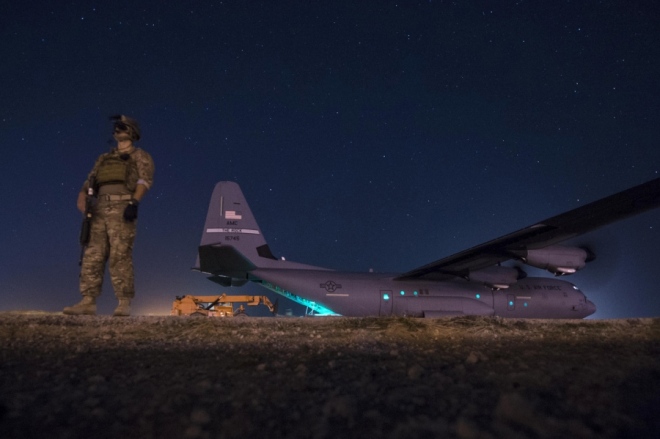
Monday September 18, 2017
A security team from the 1st Battalion, 153rd Infantry Regiment provides security for a C-130J May 26, 2017, during a cargo mission in Somalia, supporting the Combined Joint Task Force-Horn of Africa. Increasing U.S. airstrikes against the extremist group al-Shabab are part of an effort to buy time for the fledgling Somalian military.
An intensifying U.S. airstrike campaign against Somalia is unlikely by itself to defeat a resilient band of al-Qaida-aligned militants, a fact that could tempt the U.S. to wade deeper into a country faced with the departure of an African force that has offered protection for a decade.
The uptick in U.S. strikes against al-Shabab targets — 13 different attacks since June — is part of a hurried effort to degrade the long-running insurgency and buy time for Somalia’s fledgling military.
The vexing questions now are the country’s fate after the withdrawal of the African Union Mission to Somalia, set to begin next year and conclude by 2020: How much territory could be lost to al-Shabab, and how fast?
“The group (Al-Shabab) would most likely retake some lost territory should AMISOM forces withdraw before the (Somalia National Army) is capable of effective independent operations against the group,” said Robyn Mack, a spokeswoman for U.S. Africa Command. “That being said, at this time it’s too early to determine what, if any, additional support will be required from the international community when AMISOM departs.”
There is some doubt about the likely success of the airstrike campaign and the surge in land operations.
“No clear indication yet, but when pressured previously there has been a temporary degradation in both the group’s command and control and morale of the rank-and-file members,” Mack said. “However, this degradation has likely been temporary. The group has maintained the ability to resurge when pressure against them on the ground by allied/partner forces has lessened.”
When the African Union intervened in Somalia in 2007, al-Shabab was on the brink of overtaking Mogadishu and controlled large areas of territory where it enforced its rule with beheadings and mass killings.
The African Union eventually pushed the militants out of most former strongholds, but as its mission began to slow in 2016, al-Shabab made gains.
Recently, there also have been flickers of Islamic State presence in the country.
J. Peter Pham, who is under consideration by the Trump administration to serve as assistant secretary of state for Africa, said airstrikes are unlikely to defeat Shabab, which “has shown itself to be a remarkably resilient group, adapting to the shifting strategic landscape of Somalia and its neighborhood.
“Thus there is no reason to believe that it will not also survive in some fashion the recent setbacks it has suffered in terms of strikes and defections,” Pham said.
African Union and AFRICOM officials also acknowledged that Somalia’s military is unable to fight on its own against al-Shabab, which seeks to impose a strict form of Sharia law.
Somalia’s capital of Mogadishu wouldn’t fall immediately upon the AU’s departure, but it could be eventually at risk as Al-Shabab chips at surrounding territory, said Vanda Felbab-Brown, an expert on Somalia with the Washington-based Brookings Institution think tank.
“Clearly, al-Shabab understands the reality that everyone else understands as well — the writing is on the wall with the respect to the AU leaving,” Felbab-Brown said.
During the next two years, the U.S. and other Western partners are tasked with readying Somalia’s military to lead the fight, but so far the training effort lacks cohesion, analysts said.
The NATO mission in Afghanistan, where the U.S. has spent billions of dollars to build up security forces, shows the limits of “building partner capacity” in nations with governments that wield little control over their territory.
“All the problems you have in Afghanistan are all bigger in Somalia,” Felbab-Brown said. “There are massive challenges to overcome.”
Government corruption in Somalia is widespread, and clan rivalries have long confounded attempts to impose order on a country with no history of a functioning central government.
Al-Shabab, which rivals Nigeria-based Boko Haram as Africa’s deadliest terrorist group, poses a threat mainly to countries around the eastern Horn of Africa and Western interests there, but the group has threatened to widen its scope of operations. The size of the force is estimated to range from 7,000 to 10,000 fighters.